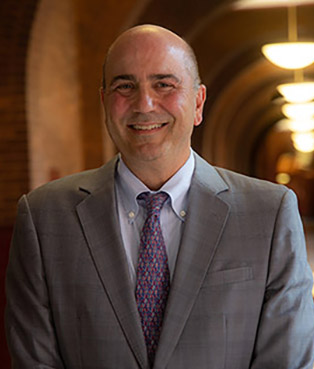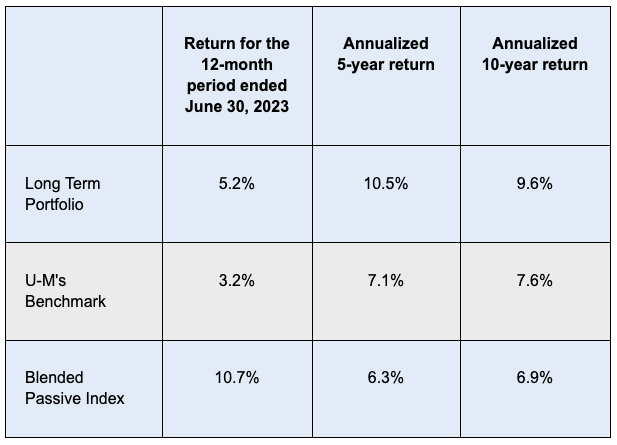Chief Financial Officer's Report

The University of Michigan has been regarded as a worldwide leader in higher education for decades. This is largely due to the high caliber of our students and faculty, the ongoing dedication of our 50,000+ employees, who have maintained an unyielding focus on supporting our missions of education, research and patient care, the generosity of our donors and support from the state of Michigan.
FY 2023 was a remarkable and transformational year for the university in many ways. President Santa J. Ono joined U-M and a number of significant initiatives began, including Vision 2034, a collective strategic visioning process to imagine our shared future for the next 10 years, which engaged U-M students, employees, alumni and partners.
The launch of Campus Plan 2050 provides an extraordinary opportunity for the U-M community to help craft a blueprint for the university’s Ann Arbor campus, with a special focus on creating the living, learning and working environments that support our strategic vision. There has also been significant progress on our sustainability efforts, including installing renewable energy infrastructure, constructing green buildings and prioritizing clean transportation. Campus improvement projects financed by our “green bonds” are addressing climate transition risks by mitigating greenhouse gas emissions from buildings and the transportation sector.

U-M continues its Culture Journey, a multi-year effort to establish, support and maintain a community where all members feel safe and supported. And we continued to lay the groundwork to launch DEI 2.0, which represents U-M’s continued commitment to ensuring a diverse, equitable and inclusive community with even more sharply defined goals, new innovations and investments and enhanced measures of accountability — shaped and informed by our own university community.
Against the backdrop of these and other major initiatives, U-M maintained its unrelenting focus on ensuring that its foundation remains strong — financially and in other ways — so it is well positioned to continue educating students from around the world, conducting research that helps society and providing outstanding health care services.
MAINTAINING A STRONG FINANCIAL POSITION
The university’s financial position continues to be strong, with total assets and deferred outflows of $34.0 billion and total liabilities and deferred inflows of $13.3 billion at June 30, 2023. Net position, which represents the residual interest in the university’s total assets and deferred outflows after total liabilities and deferred inflows are deducted, totaled $20.7 billion at June 30, 2023.
While net investment income can be volatile from year to year, our endowment distribution policy and long-term investment strategy combine to insulate U-M from volatility and provide dependable annual support for operations. The endowment distribution policy smooths the impact of capital market volatility by providing for annual distributions of 4.5 percent of the seven-year moving average fair value of the University Endowment Fund. This policy, along with the endowment’s growth, allowed for distributions of $470 million to support university operations in FY 2023, for a total of $2.1 billion over the past five years. Distributions from more than 12,600 individual endowments provide ongoing and dependable support for a variety of academic, health-related and other needs across the university such as student scholarships, professorships, clinical operations and research.
Endowment funds, which are invested principally in the university’s Long Term Portfolio, totaled $17.9 billion at June 30, 2023. The table below summarizes the investment performance of U-M’s Long Term Portfolio in relation to comparative benchmark portfolio returns.
INVESTMENT PERFORMANCE

Financial markets generally saw positive returns in FY 2023 despite persistent high inflation, high interest rates, a restrictive central bank policy and increased geopolitical tensions. U-M’s Long Term Portfolio generated a 5.2 percent return for the year against this backdrop, which was among the highest of the 25 largest university endowments.
The university’s approach to diversifying the portfolio has helped over longer time periods. With a 5-year annualized return of 10.5 percent and a 10-year annualized return of 9.6 percent, the Long Term Portfolio is in the top quartile of performance relative to other college and university endowment investment portfolios. Similarly, the Long Term Portfolio’s 20-year annualized 9.9 percent return is well into the top quartile of performance and compares well to the 7.6 percent annualized return for the median university endowment over the same period.
DIVERSIFICATION IN REVENUE STREAMS
U-M has a diversified revenue base, which has enabled the university to remain financially stable through various economic cycles and challenges as well as avoid unnecessary dependence on student tuition and fee increases. The components of the university’s sources of revenue are depicted below.
Funding from the state of Michigan continues to be an essential source of financial support for U-M. In FY 2023, state educational appropriations totaled $393 million. We are very appreciative of the continued support of higher education and U-M by the residents of our state.
U-M’s operating budget continues to balance academic excellence and investment in the future with student affordability and access. For the Ann Arbor campus, tuition rate increases for FY 2023 were 3.4 percent for in-state undergraduate students and 3.9 percent for nonresident undergraduate students and most graduate students. For the Dearborn campus, tuition rate increases for undergraduate and graduate students were 3.6 percent and the Flint campus saw a 4.9 percent increase in undergraduate rates and a 4.5 percent increase for graduate students.
The FY 2023 budget also included a 5 percent increase in financial aid for undergraduates on the Ann Arbor campus, with 12 percent and 9 percent increases in institutionally awarded aid on the Dearborn and Flint campuses, respectively. U-M has been able to limit tuition increases and provide generous financial aid due to ongoing growth in non-tuition revenues and a long-standing commitment to controlling costs and improving efficiencies.
Demand for a U-M education continues to grow. More than 95,000 prospective first-year-student applications — a record number — were submitted from around the world for the university’s three campuses. This is the 16th consecutive year that applications have increased. U-M’s impressive global reputation and incredible value make it a top destination for outstanding students from Michigan, the United States and countries around the world.
ADDRESSING BOLD CHALLENGES THROUGH RESEARCH
As part of its universitywide commitment to serve the world through research, scholarship and creative practice, diverse teams from across the three U-M campuses worked together during FY 2023 to catalyze new knowledge and discoveries for the betterment of society.
The university reported a record $1.86 billion volume of research expenditures during FY 2023, driving advancements to address critical challenges ranging from global carbon emissions and youth firearm violence to structural racism and substance use disorders. Total research volume increased by 8.1 percent when compared to FY 2022 and U-M also secured 1,974 new research awards during FY 2023.
The university continues to strengthen its partnerships with the federal government, a primary sponsor of U-M research, scholarship and creative practice. During FY 2023, research expenditures sponsored by federal agencies totaled $1.05 billion, which accounts for more than half of the university’s total research volume.
As a leading public research university, U-M continues to embrace its unique responsibility to translate new knowledge and discoveries from its laboratories, studios and research spaces for broad societal impact. The university is in the top five nationally for new invention reports and the execution of new licenses and options, according to the latest rankings from the Association of University Technology Managers.
GROWING COMPREHENSIVE ACADEMIC MEDICAL CENTER
Michigan Medicine — which includes University of Michigan Health, University of Michigan Medical School, Michigan Health Corporation and UM Health — is widely acknowledged across the country as a leader in advanced patient care, innovative research to improve human health and comprehensive education of physicians and medical scientists.
During 2023, the university completed a significant affiliation with Sparrow Health System and it is now part of UM Health, our wholly owned corporation created to hold and develop the university’s statewide network of hospitals, hospital joint ventures and other hospital affiliations. Sparrow has more than 120 sites of care and is one of the largest health systems in Michigan, with about 10,000 caregivers and approximately 600 employed primary-care providers and specialists.

Construction of the D. Dan and Betty Kahn Health Care Pavilion continues. The new hospital will house 264 private rooms capable of converting to intensive care, a state-of-the-art neurological and neurosurgical center, high-level specialty care services for cardiovascular and thoracic patients and advanced imaging services. In addition, a new specialty and mail pharmacy facility will allow Michigan Medicine to significantly expand its services and more than double the number of prescriptions it fills each year through its in-house pharmacy.
Moving forward, Michigan Medicine will continue to invest in its people and innovative ways to provide high-quality care across the state, including building on its new affiliation with Sparrow.
A BRIGHT FUTURE FOR MICHIGAN
Because of its financial strength, the University of Michigan remains well positioned for the future. U-M is one of only seven public universities in the country to earn the highest possible credit ratings from S&P Global (AAA) and Moody’s (Aaa). We’ve maintained these outstanding ratings for years, which is a clear indication of our long-term financial strength and stability.
To maintain excellence in education, research and patient care as well as offer collaboration opportunities for multiple disciplines, U-M makes important capital investments in a wide array of its facilities. An overview of the capital projects completed, in progress and in planning during FY 2023 appears in the Major Projects section. U-M has long balanced investing in new facilities against renewing existing facilities, which enables us to avoid an excessive accumulation of deferred facility maintenance.
I hope you’ll review Management’s Discussion and Analysis in conjunction with the audited financial statements. This section of the annual report includes additional details about U-M’s financial strength, prudent financial policies and commitment to excellence. When combined with our dedicated employees, these factors allow U-M to continue making contributions that enrich the world.
Sincerely,

Geoffrey S. Chatas
Executive Vice President and Chief Financial Officer
